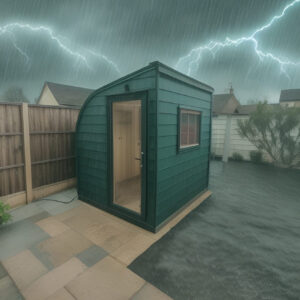
Flexible working is most certainly ‘a thing’. A quick scroll through popular job search sites soon highlight just how many employers are offering remote or hybrid working opportunities. With rising transport costs and energy costs, working from home is still on the minds of many.
Where to begin? A quick internet search for garden office UK will return three billion, six hundred and forty million results! There are a huge number of companies that are either repurposing existing structures to sell as the perfect office or designing and creating a completely new structure for the householder.
The vast majority of these products fall into the range of shed, shoffice or garden rooms. But what is the difference and what are the pros and cons of either one?
Shed
The humble shed – for the longest time it has been the dumping ground of gardening tools, DIY equipment and summer toys for the children. A much loved refuge of mice in the winter and arachnids in the summer no one could have ever predicted it would lead the revolution in working from home. However, during lockdown, the ability to have a shed delivered with a little self-assembly proved the saviour for those working from a kitchen table. It was a cheap and quick fix.
What soon became apparent was that any concept of durability or comfort soon disappeared. While it may have been a quiet while children were home learning – it was still a shed. With a less than reassuring bouncy floor, super thin walls and a paper felt roof you soon felt like the second little piggy in that classic bed time story! And let’s not mention being encased in flammable material in a shed that is in close proximity to barbeques, fire pits and often has questionable electric supplies though various extension cables. Zurich insurance listed the shed office as the greatest casualty of lockdown with a 20% increase in shed blazes…
With no base, insulation, heating, electrics or double glazing you truly get what you pay for.
Shoffice
The office in a shed or ‘shoffice’ differs from the shed in that is seen as a more permanent solution to the workplace dilemma. A shoffice is more likely to be a larger and more robust build than a typical shed. With larger doors and windows, expect something akin to a small log cabin or wooden summer house. These are traditionally made of thicker shiplap timber rather than the cheap and pliable feather board that makes up most sheds. Build quality varies significantly with some shiplap being constructed of halved ‘logs’.
Seen as better value for money than its shed counterpart, it benefits from being lighter and airier. This does make it feel a much more comfortable place to work within and its heavier construction feels more substantial. Yet, sheds and shoffices essentially use one layer of material that is both the inner skin and the outer skin of a build. This can cause issues with damp and uncomfortable temperatures during the summer and winter.
Products available within the shoffice range offer an incredible spectrum. Most shoffice buildings are essentially a shell. Take careful note of what you are getting for your money as options and prices vary considerably. It is not unusual to buy a shoffice for £3,500 and then find your delivery, installation, insulation and wiring adds the same amount again.
Also take care with the size of the building itself. While most fall under permitted development and do not need planning permission; larger and taller builds most certain will. If you are in a Conservation Area or own Listed Building etc. you should always seek planning advice.
Garden rooms
These are the epitome of garden offices and can have a price tag to match, but with this comes a greater quality of design and material than a typical shoffice build.
Within this subset of garden office, expect to see fully insulated rooms that allow you to work comfortable through the winter and summer. Builds of this calibre essentially have cavity wall insulation – be wary of what type of insulation is being used though; structurally insulated panels (SIP) are a sandwich of wooden formed panels and foam insulation. They are very cheap to build with, hence their popularity, but can have real issues with moisture and pests that cannot be easily undone. Traditional rock wool insulation as seen in lofts and attics does not have the same problem and should come with a high quality vapour layer that lets the building breathe. Mice do like rock wool however, so make sure that the room is fully sealed and remains enclosed (wooden facades can warp and shrink over time).
Again, so many options are available within the garden room market. It is worth considering how long you want to keep your office and will you get that return on the investment should you sell? A garden room that is designed as an office pod has the added benefit of being transportable. There are also modular garden offices that can be assembled of disassembled within the day. Purchasing one of these for less than £9,000 with the ability to get a good resale value on it can be tempting. If you are looking for a permanent fixture, prepare to pay upwards of £20,000. Consulting with an estate agent to see if this would provide a return on your house price is prudent. There are many cautionary tales regarding significant investments in garden rooms that do little to the overall value of the home.
In summary, careful consideration of your long-term plans and use of your space is paramount when making that final investment. Although there is a significant leap in price between the shoffice and garden room, durability and comfort do require higher spec and higher quality materials. Deciding upon whether that increased cost provides a corresponding improvement of functionality throughout the seasons or more of a long-lasting investment remains key.





